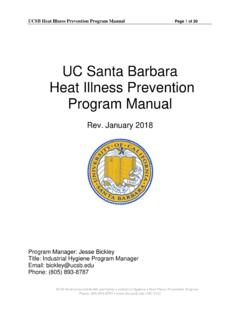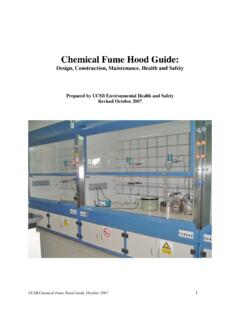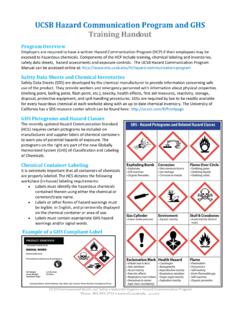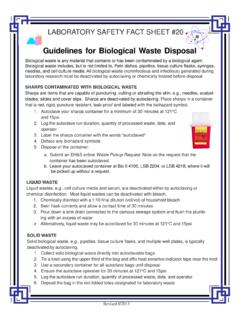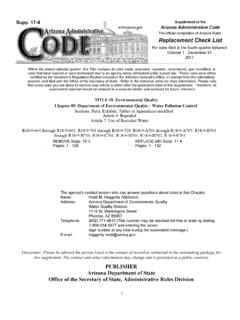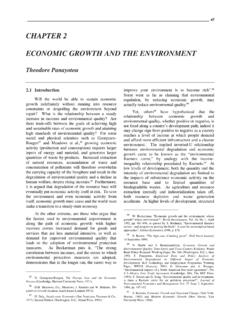Transcription of Chapter 2 - Physics of Diving - UC Santa Barbara
1 Physics ofDivingSECTIONPAGE2. 0 GENERAL ..2- 12. 1 12. Atmospheric 12. Hydrostatic Pressure ..2- 12. Absolute 12. Gauge 22. Partial Pressure ..2- 22. 2 DENSITY ..2- 32. Specific Gravity ..2- 32. 3 WATER ..2- 32. Freshwater ..2- 32. 32. 42. 4 UNITS OF 42. Length ..2- 42. Area ..2- 42. Volume ..2- 42. Weight ..2- 42. 5 42. Heat ..2- 62. 6 BUOYANCY (Archimedes Principle) ..2- 62. 7 GASES USED IN Diving ..2- 72. Atmospheric Air ..2- 72. Oxygen (O2) ..2- 72. Nitrogen (N2) ..2- 82. Helium (He)..2- 82. Carbon Dioxide (CO2)..2- 82. Carbon Monoxide (CO) ..2- 82.
2 Argon (Ar), Neon (Ne), Hydrogen (H2)..2- 82. 8 GAS 92. Boyle s 92. Charles /Gay-Lussac s Dalton s Law ..2-112. Henry s Law ..2-122. General Gas Law ..2-132. 9 MOISTURE IN BREATHING Condensation in Breathing Hoses or Mask ..2-152. Fogging of the LIGHT .. Colors .. SOUND .. GENERALIn all Diving operations, safety is the primary considera-tion. One key to safety is a clear understanding of the physicsof Diving . Physics is the field of science dealing with matterand energy and their interactions. This Chapter exploresphysical laws and principles that pertain to the Diving envi-ronment and its influence on the diver.
3 Gravity is passive,vision and hearing may be misleading, color perceptionchanges at varying depth, and breathing dynamics are everchanging. The principles of Physics provide the keystone forunderstanding the reasons for employing various Diving pro-cedures and the operation of associated equipment. Many ofthese principles receive further elaboration in other sectionsof the NOAA Diving PRESSUREP ressure is force acting on a unit mathemati-cally,Pressure = force/area P = F/AIn the United States, pressure is typically measured inpounds per square inch (psi). Under water, two kinds ofpressure affect a person, the weight of the surroundingwater and the weight of the atmosphere over that concept that must be remembered at all times is: adiver, at any depth, must be in pressure balance with theforces at that depth.
4 At all depths, the diver must compensate for the pres-sure exerted by the atmosphere, by the water, and by thegases being used for breathing under water. This compen-sation must always be thought of in terms of attaining andmaintaining a balance between the pressure inside the bodyand the external Atmospheric PressureAtmospheric pressure is the pressure exerted by theearth's atmosphere; it decreases with altitude above sealevel. At sea level, atmospheric pressure is equal to per square inch (psi) or one atmosphere (atm). Thehigher the altitude above sea level, the lower the atmospher-ic pressure. For example, at 18,000 ft. (5,486 m), atmos-pheric pressure is psi, or half that at sea level (seeFigure ).
5 At sea level, atmospheric pressure is consideredconstant and universal; that is, anywhere on the earth at sealevel, the pressure is psi. The pressure inside a person slungs is the same as the pressure Hydrostatic PressurePressure due to the weight of water is called hydro-static pressure. The weight of water is cumulative; thedeeper the dive, the more water there is above the diverand the greater the weight of that water. This weightaffects a diver from all sides equally and increases at arate of psi per foot of seawater. Thus, at a depth of33 ft. ( m) of seawater (fsw), the hydrostatic pressureis psi, or one atmosphere, the same pressure asatmospheric pressure at sea level.
6 In freshwater, 34 ft.( m) equals psi or psi per foot of freshwa-ter (ffw). Thereafter, for every 34 ft. of additional depth infreshwater, the hydrostatic pressure increases by oneatmosphere (see Figure ). Absolute PressureThe sum of atmospheric pressure plus hydrostaticpressure is called the absolute pressure. Absolute pres-sure can be expressed in many ways, including "poundsper square inch absolute" (psia), "atmospheres absolute"(ata), feet of seawater absolute (fswa), feet of freshwaterabsolute (ffwa), or millimeters of mercury absolute(mmHga).To understand the effects of absolute pressure on adiver, consider this: the feet of a 6-foot tall man standingunder water will be exposed to pressure that is almostthree pounds per square inch greater than that exerted athis of Diving2-2 NOAA Diving one square inch columnof air extending from sea levelto the top of the atmosphereweighs lbs.
7 One half ofthe weight is contained in thefirst 18,000 ft. (5,486 m or3 1/2 miles) of the column. one-inch square column of seawater 33 ft.( m) deep and a column offreshwater 34 ft.( m) deepeach weigh lbs. a depth of 34 ft. ( m)of freshwater, the sum ofatmospheric and hydrostaticpressures equal AIR lbs. at 18,000 lbs. Total weight of air and water at 34 lbs. at Sea Level1 sq. Level1 sq. sq. OF Gauge PressureThe difference between atmospheric pressure and thepressure being measured is gauge pressure. Consider thepressure gauge on a scuba tank, for instance. The zeroreading on the gauge before it is attached actually repre-sents the ambient atmospheric pressure.
8 To put it anotherway, at sea level, the zero on the tank gauge actually repre-sents psia. Thus, the pressure in the tank is referred toin terms of "pounds per square inch gauge" (psig). To con-vert gauge pressure to absolute pressure, add Partial PressureIn a mixture of gases, the proportion of the total pres-sure contributed by each gas in the mixture is called the partial pressure. Although traces of other gases are alsopresent in atmospheric air, for our discussion here, we canapproximate that atmospheric air is composed of 21% oxy-gen and 79% nitrogen, for a total of 100%, or one atmos-phere absolute. The impact of partial pressures upon thediver is explained in detail later in this Chapter under Dal-ton's LevelFIGURE Weight of Air and WaterPhysics of Diving2-3 The body can function normally only when the pres-sure difference between the inside of the body and the out-side is very DENSITYD ensity can be defined as weight per unit mathematically, Density = Weight/Volume or D = W/VDensity is expressed in pounds per cubic foot (lbs/ft3)or in grams per cubic centimeter (g/cm3).
9 Gas density is related to absolute pressure. As depthincreases, the density of the breathing gas increases andbecomes heavier per unit volume. High gas densityincreases the effort required to breathe and limits a diver sability to ventilate the lungs adequately, especially duringstrenuous exercise and at deeper depths (see Table ).Freshwater has a density of pounds per cubicfoot. Seawater has a density of pounds per cubicfoot (see Figure ). As a result, freshwater floats on topof seawater and a diver floats easier in seawater than Specific GravitySpecific gravity is the ratio of the weight of a givenvolume of a substance (density) to that of an equal vol-ume of another substance (water [for liquids and solids]and air [for gases] are used as standards).
10 Water has aspecific gravity of at F (4C). Substances that aremore dense than freshwater have a specific gravitygreater than Thus, the specific gravity of seawater = WATERP hysical laws that act upon a person above the sur-face of water also apply below the surface. As a diverdescends into the water, those forces increase; the divershould be aware of these FreshwaterWater, H2O, is a major constituent of all living mat-ter. It is an odorless, tasteless, very slightly compressibleliquid oxide of hydrogen, which freezes at 32 F (0C), andboils at 212 F (100C). In its purest form, water is a poorconductor of SeawaterSeawater contains just about every substance chloride (common table salt) is the most abun-dant chemical.



